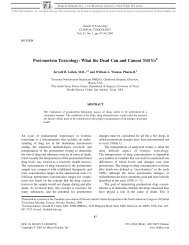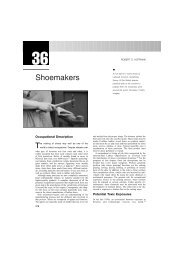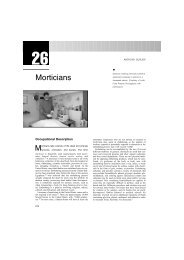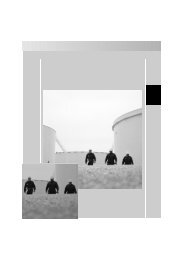9. Treatment of Amatoxin Poisoning-20 year retrospective analysis
9. Treatment of Amatoxin Poisoning-20 year retrospective analysis
9. Treatment of Amatoxin Poisoning-20 year retrospective analysis
You also want an ePaper? Increase the reach of your titles
YUMPU automatically turns print PDFs into web optimized ePapers that Google loves.
740<br />
Figure 1. Effect <strong>of</strong> the modes <strong>of</strong> care (supportive measures<br />
alone and 10 specific treatments) on the distribution <strong>of</strong> treated<br />
patients in terms <strong>of</strong> survivors and deceased (histograms<br />
including liver transplants), and percentages <strong>of</strong> deceased<br />
patients vs. treated with and without liver transplants (curves).<br />
survLT: survivors including liver transplants; decLT: deceased<br />
including liver transplants; MRLTi: mortality rate including<br />
liver transplants; MRLTe: mortality rate excluding liver<br />
transplants. Supportive M. ¼ supportive measures alone<br />
(Table 1); BpThioca ¼ benzylpenicillin/thioctic acid; Bpw-<br />
SilybTriPoly ¼ benzylpenicillin/drugs without silybin as triand<br />
poly-chemotherapies; BpSter ¼ benzylpenicillin/steroid;<br />
Bp ¼ benzylpenicillin; Detox ¼ detoxication procedures alone<br />
(Table 2); BpantiOx ¼ benzylpenicillin/antioxidant drug<br />
(cimetidine, N-acetylcysteine or vitamin C); Nac ¼<br />
N-Acetylcysteine; BpSilyb ¼ benzylpenicillin/silybin;<br />
BpSilybTriPoly ¼ benzylpenicillin/drugs with silybin as triand<br />
poly-chemotherapies; Silyb ¼ silybin.<br />
clinical research to pursue, and provide a basis for the<br />
discontinuation <strong>of</strong> the clearly less effective therapies.<br />
Investigations for amatoxin treatment should focus on<br />
detoxication procedures, silybin, and NAC. Assessment<br />
<strong>of</strong> more cases would be useful to confirm their benefit.<br />
Clinical data from this <strong>20</strong>-<strong>year</strong> period do not show<br />
benzylpenicillin to be an effective drug; this antibiotic<br />
agent did not enhance the efficacy <strong>of</strong> either silybin or<br />
NAC in the treatment <strong>of</strong> amatoxin syndrome. Perhaps<br />
benzylpenicllin, thioctic acid, and steroids should be<br />
abandoned as therapeutic modalities.<br />
MARCEL DEKKER, INC. 270 MADISON AVENUE NEW YORK, NY 10016<br />
©<strong>20</strong>02 Marcel Dekker, Inc. All rights reserved. This material may not be used or reproduced in any form without the express written permission <strong>of</strong> Marcel Dekker, Inc.<br />
SUMMARY<br />
Enjalbert et al.<br />
Although the treatment <strong>of</strong> patients exposed to<br />
amatoxin-containing mushrooms has become more<br />
sophisticated, the optimal management <strong>of</strong> the poisoning<br />
is still not determined. Options include various detoxication<br />
procedures, chemotherapies, and liver transplant in<br />
case the hepatic disease reaches a potentially fatal stage.<br />
The clinical efficacy <strong>of</strong> any modality <strong>of</strong> treatment for<br />
amatoxin poisoning is difficult to demonstrate since<br />
randomized, controlled clinical trials verified within the<br />
frame <strong>of</strong> multicenter studies have not been reported. The<br />
use <strong>of</strong> drug combinations also limits the evaluation <strong>of</strong><br />
individual efficacy <strong>of</strong> the therapeutic modalities. The<br />
theoretical and experimental bases for antitoxic action <strong>of</strong><br />
most <strong>of</strong> these agents are not clearly established. Silymarin<br />
complex and free radical scavengers (cimetidine, NAC,<br />
vitamin C) have respective hepatoprotective and antioxidant<br />
properties that yield convincing support for their use.<br />
LT is accepted as a life-saving procedure in amatoxin<br />
poisoning cases leading to acute massive hepatic<br />
necrosis. Early identification <strong>of</strong> liver dysfunction, rapid<br />
evaluation <strong>of</strong> suitability for transplant, immediate listing,<br />
and an available donor research are crucial. It is<br />
important to verify that the prognostic indications for LT<br />
are defined and met.<br />
Our <strong>retrospective</strong> data determined the use and the<br />
mortality rate for each treatment in this overall<br />
compilation <strong>of</strong> heterogeneous subjects. For statistical<br />
<strong>analysis</strong> relative to MR, the 32 amatoxin victims<br />
receiving LT were considered as special cases and<br />
were either excluded from the group <strong>of</strong> treated patients<br />
(MRLTe), or since their outcome was considered<br />
virtually fatal without transplantation, were included as<br />
deadly cases (MRLTi).<br />
Benzylpenicillin, despite mechanism <strong>of</strong> its action<br />
poorly argued, was the most frequently administered<br />
agent (86.5%). Silybin was given to 38.2% <strong>of</strong> patients.<br />
Among the antioxidant drugs, NAC was the most<br />
frequently prescribed agent, utilized in 11.8% <strong>of</strong> cases.<br />
Comparison <strong>of</strong> the mortality rates <strong>of</strong> 11 modes <strong>of</strong> care<br />
representing sufficient numbers <strong>of</strong> patients for statistical<br />
<strong>analysis</strong> showed that supportive measures alone resulted<br />
in high mortality comparable to historical data (.40%).<br />
The mortality rates <strong>of</strong> detoxication procedures alone<br />
were comparable to those <strong>of</strong> the nine combined<br />
chemotherapies suggesting a benefit due to amatoxin<br />
removal after initial absorption. Case data and numbers<br />
were insufficient to allow a comparison <strong>of</strong> the MR <strong>of</strong> the<br />
nine chemotherapies used with and without detoxication








